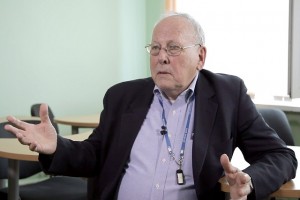Temporal Discounting
Neuroscientist Samuel McClure on why we violate our best intentions, ‘dual selves model’, and pathways in our ...
There is a subject in economics that is usually called microeconomics, and I believe it shouldn’t be. Because microeconomics suggests that it’s only about small-scale things, and, in fact, the world wheat market is a topic in microeconomics – not in what’s called macroeconomics. That’s as in many other cases and fields people come up with some simple name, which seems to explain things and it lets them believe they understand things without doing the work of really understanding them. I think, price theory is a better title for the same thing. What it’s really about is how we solve the impossible problem of getting a society of millions of people to work.
If you think about it for a while, pretty nearly everything you use requires more than a million people to make it, if you trace back the whole sequence of clauses. So, a standard example that someone thought up long before me is a pencil. How many people make a pencil? To have a pencil you need wood, to have wood you need lumber, to have lumber you need chainsaws to cut the trees down, to have chainsaws you need steel, to have steel you need coal and iron, and electricity, and blast furnaces.
I’ve only followed one chain down. You also need gasoline to run the chainsaw, and for the gasoline you need drills to drill oil wells, and pumps, and refineries. I’ve only gotten to the wood so far. The pencil has also got what’s called lead, which is actually graphite. It also has a little metal band around it, at the back it’s got a little eraser. If you trace all of those things down and you ask how many people through the whole pattern contributed to making that pencil, it literally is in the millions. And that’s true of everything. Then the question is: how do you coordinate them? How do you make sure there is the right amount of wood for making pencils, and the right amount of steal for making chainsaws, and cars, and everything else?
Once you start thinking seriously about that mathematical problem, it looks pretty impossible to solve. There are basically only two approaches to solving the problem, and one of them doesn’t work. The one that doesn’t work is the obvious solution. And that is you have somebody at the top who tells everybody what to do. That works for very very small projects, for a family, or maybe a one person- or two-person firm. But as the number of people gets larger, the calculation becomes impossibly difficult even with computers. The individual at the top doesn’t know what he has to know. He doesn’t know who has what skills, who wants what things and so forth. He can’t see what’s happening, because all the information is filtering through many layers of people in between. The central planning solution, which looks like the obvious way of coordinating, breaks down very badly when you do it on a large scale.
The alternative approach is to somehow break up the problem in such a way that each person is solving a little tiny piece of it, and then their activities are coordinated. If I’m somebody who is in the business of cutting down trees, I can solve the little part of it, which is how much time do I want to spend, where do I want to work, what company do I go to work for exactly, how do I cut down the tree and so forth. Each part of it is being solved by a different person. For that to work you need somehow a reason why, when I solve my part, I’m doing the right thing for the rest of you.
The basic way, in which that’s done in a market system, is through prices and trade. If, in fact, people want more wood than is being produced for houses and pencils and everything else, the result is that the price of wood goes up. When the price of good wood goes up, that is a reason for people who are cutting down trees to cut down more trees. They then want more chainsaws. That’s a reason why the price of chainsaws goes up, and why the people who make chainsaws make more chainsaws. If the price of wood goes up, some people who could use either wood or aluminum for something use aluminum instead, because it’s more expensive. So, if you think it through, the prices are the signals, by which everyone wants and does is communicated to everybody else in a way that not only gives you the information, but gives you an incentive to act on it. The fact that the price of wood goes up doesn’t just mean people want more wood. It also means that if I’m in the business of producing wood, it’s in my interest to reduce more of it. So I’ll get paid for producing more of it.
The way you usually do price theory in a textbook is you start out in a relatively simple world, which is easier to analyze, in a world in which for every product there are many people producing it. Therefore, each person simply takes the prices given. Whereas sometimes you’re in a situation where there are only few people producing something. The company would say: “well, if I produce more, I’ll sell more”. But that will push the price down. So that’s a trade-off.
You start usually with the simple model which economists call perfect competition, and it turns out that in that model the price ends up both equal to the value of a little bit more of whatever it is to however we get that little bit more, and equal to the cost to whoever produces it of producing a little bit more. These are what economists call marginal value and marginal cost. That means that when you are deciding whether to use something, if you use it, that means either somebody else produces a little more, or somebody else consumes a little less.
If a particular thing is worth 10 rubles to you, and the price is 8 rubles, that means that when you use it, you get a ten ruble benefit. That’s why you’d be willing to pay that much. Either the producer asked to spend another eight rubles making a little bit more of it, or some other consumer doesn’t get it and loses 8 rubles worth of use. But that means that 10 ruble gain for an 8 ruble loss. On that people are better off as a result. And that’s a simple version of what sometimes is referred to as an efficiency theorem, which basically says that in the simplified world of perfect competition the prices give exactly the right signal. That they give the signal that means that each person is making the decision that maximizes the total benefit to everybody. That the price is the cost of making it. You buy it when it’s worth more than the cost. That’s the efficient solution. It’s the value to other users. You use it when it’s worth more to you than to them. That’s the efficient solution. Therefore price theory is really the explanation of how markets work.
One of the patterns one observes in the academic world, at least in America, is that most academics are politically left and economists are less politically left than other academics. I think, the reason for that is that the strongest argument against free markets is not seeing how it’s possible to coordinate without control. It seems intuitively as if nobody is in charge of doing things, they don’t get done, and, therefore, the system without government control ought to be chaos. You can’t be an economist and believe that that the first step to being an economist is understanding how the decentralized coordination of the market works. It might not work perfectly, you might be an economist, and the perfect competition model is very pretty, but here are the reasons why there’s a monopoly or something else you need government to intervene. That’s a complicated argument and economists will disagree on it.
That’s a very very important lesson, because essentially in order to believe in individual freedom, you have to believe that somehow if you leave people alone things will work out mostly right. Price theory does not guarantee that. There are situations that we described as market failure, where even if individuals make the right decision, the group makes the wrong decision.
If you look on my web page, one of the talks I’ve given, and you can find a recording of it, is about market failure. What I’m arguing there is: those situations exist on the market, but they also exist in the political system. That in fact the kind of situation, where everyone makes the right choice for himself, but the wrong choice for everyone is the exception on the private market and what normally happens in the political market. Because it happens when one person makes the decision where someone else bears the cost.
In the private market you can occasionally do that. If I burn leaves on my lawn, my neighbors may get smoke they don’t like. So once in a while in the private market one person does something, but someone else bears the cost. But most of the time if I want to have steak for dinner, I’ve got to pay somebody to get that steak. That means that I’m not imposing a cost on him. But if you think about how the political system works, it’s almost never the case that when a politician votes for something, whether it’s benefit or cost, he doesn’t get the benefit he doesn’t pay the cost. When a judge makes a decision, if it’s the wrong decision he’s not the one who’s worse off as a result. I would argue that because you have these situations where individual irrational behavior doesn’t lead to group rational behavior, that’s usually an argument against government’s doing things, because although it happens in the private market, it happens more in the political market.
If you think of the political system not as a benevolent God doing things for you, but as a bunch of human beings like everything else each doing his own thing and each one pursuing his own objective is not the welfare of the world. The beauty part of what price theory tells us is that at least in the case everybody trying to pursue his own objectives does produce the welfare of the world. In some complicated cases it doesn’t, and that’s a very interesting lesson, probably the most interesting and important single lesson in economics.
I rewrote the textbook later as a book that was intended for the intelligent laymen who wants to teach himself economics. That book is called “Hidden Order”. That one you can’t read online or at least not from my webpage, because my publisher wouldn’t let me put it up on my webpage. I don’t know if there is a Russian translation. It’s been translated into a fair number of languages, and I don’t know if somebody just told me yesterday that a different book of mine has been translated into Russian, which I didn’t know. But for people who read English at least you can buy that book, you can probably get it as a Kindle, maybe you can find it in a library and I’m not sure, if you can find it in Russian or not. But that was an attempt to do the same thing the “Price Theory” book does, but as a book that people would read for the fun of it. I think that books written to be read for the fun of it are usually better books than books written by an author who knows that a professor is going to make somebody read them.

Neuroscientist Samuel McClure on why we violate our best intentions, ‘dual selves model’, and pathways in our ...

Political scientist Daniel Treisman on Aristotle, revolutions, and misperceptions of levels of inequality

Historian of science Loren R. Graham on the mistakes Russian leaders make, intellectual property and risky inv...